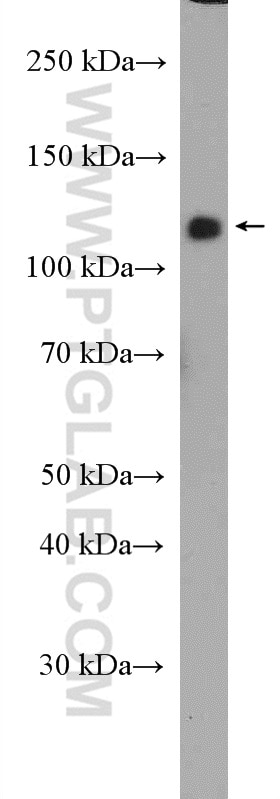CNTNAP3 Polyklonaler Antikörper
CNTNAP3 Polyklonal Antikörper für WB, ELISA
Wirt / Isotyp
Kaninchen / IgG
Getestete Reaktivität
human
Anwendung
WB, ELISA
Konjugation
Unkonjugiert
Kat-Nr. : 27410-1-AP
Synonyme
Geprüfte Anwendungen
| Erfolgreiche Detektion in WB | HEK-293-Zellen |
Empfohlene Verdünnung
| Anwendung | Verdünnung |
|---|---|
| Western Blot (WB) | WB : 1:500-1:2000 |
| It is recommended that this reagent should be titrated in each testing system to obtain optimal results. | |
| Sample-dependent, check data in validation data gallery | |
Produktinformation
27410-1-AP bindet in WB, ELISA CNTNAP3 und zeigt Reaktivität mit human
| Getestete Reaktivität | human |
| Wirt / Isotyp | Kaninchen / IgG |
| Klonalität | Polyklonal |
| Typ | Antikörper |
| Immunogen | CNTNAP3 fusion protein Ag26624 |
| Vollständiger Name | contactin associated protein-like 3 |
| Beobachtetes Molekulargewicht | 124 kDa |
| GenBank-Zugangsnummer | BC132737 |
| Gene symbol | CNTNAP3 |
| Gene ID (NCBI) | 79937 |
| Konjugation | Unkonjugiert |
| Form | Liquid |
| Reinigungsmethode | Antigen-Affinitätsreinigung |
| Lagerungspuffer | PBS with 0.02% sodium azide and 50% glycerol |
| Lagerungsbedingungen | Bei -20°C lagern. Nach dem Versand ein Jahr lang stabil Aliquotieren ist bei -20oC Lagerung nicht notwendig. 20ul Größen enthalten 0,1% BSA. |
Hintergrundinformationen
CNTNAP3 belongs to the Neurexin superfamily and is a member of the Contactin-Associated Protein (CNTNAP) family, which also includes well-studied members like CNTNAP2. CNTNAP3 is predominantly expressed in the central nervous system (CNS), including regions such as the cerebral cortex, hippocampus, and cerebellum. Its expression is primarily in neurons. Compared to its family member CNTNAP2, CNTNAP3 expression begins later in development and persists into adulthood, suggesting roles in both developmental processes and the maintenance of mature neural circuits.
Protokolle
| PRODUKTSPEZIFISCHE PROTOKOLLE | |
|---|---|
| WB protocol for CNTNAP3 antibody 27410-1-AP | Protokoll herunterladen |
| STANDARD-PROTOKOLLE | |
|---|---|
| Klicken Sie hier, um unsere Standardprotokolle anzuzeigen |


